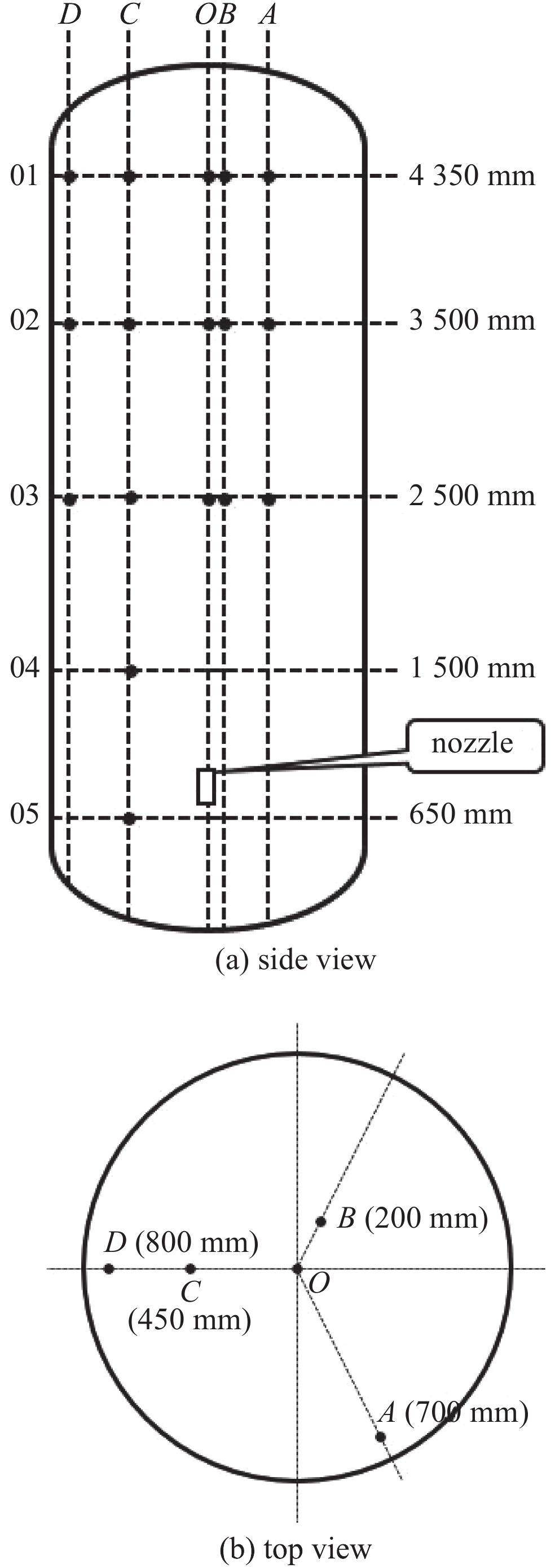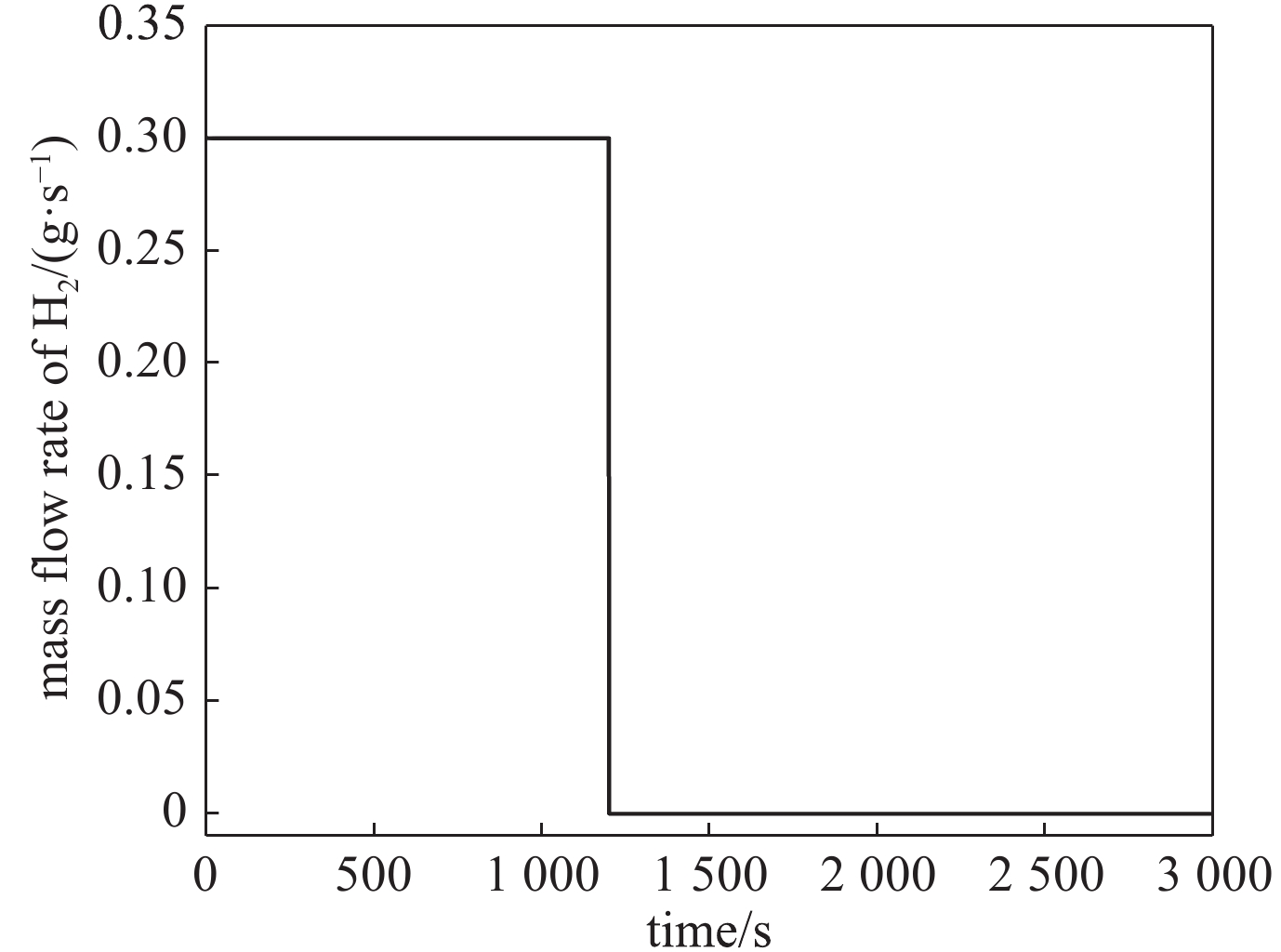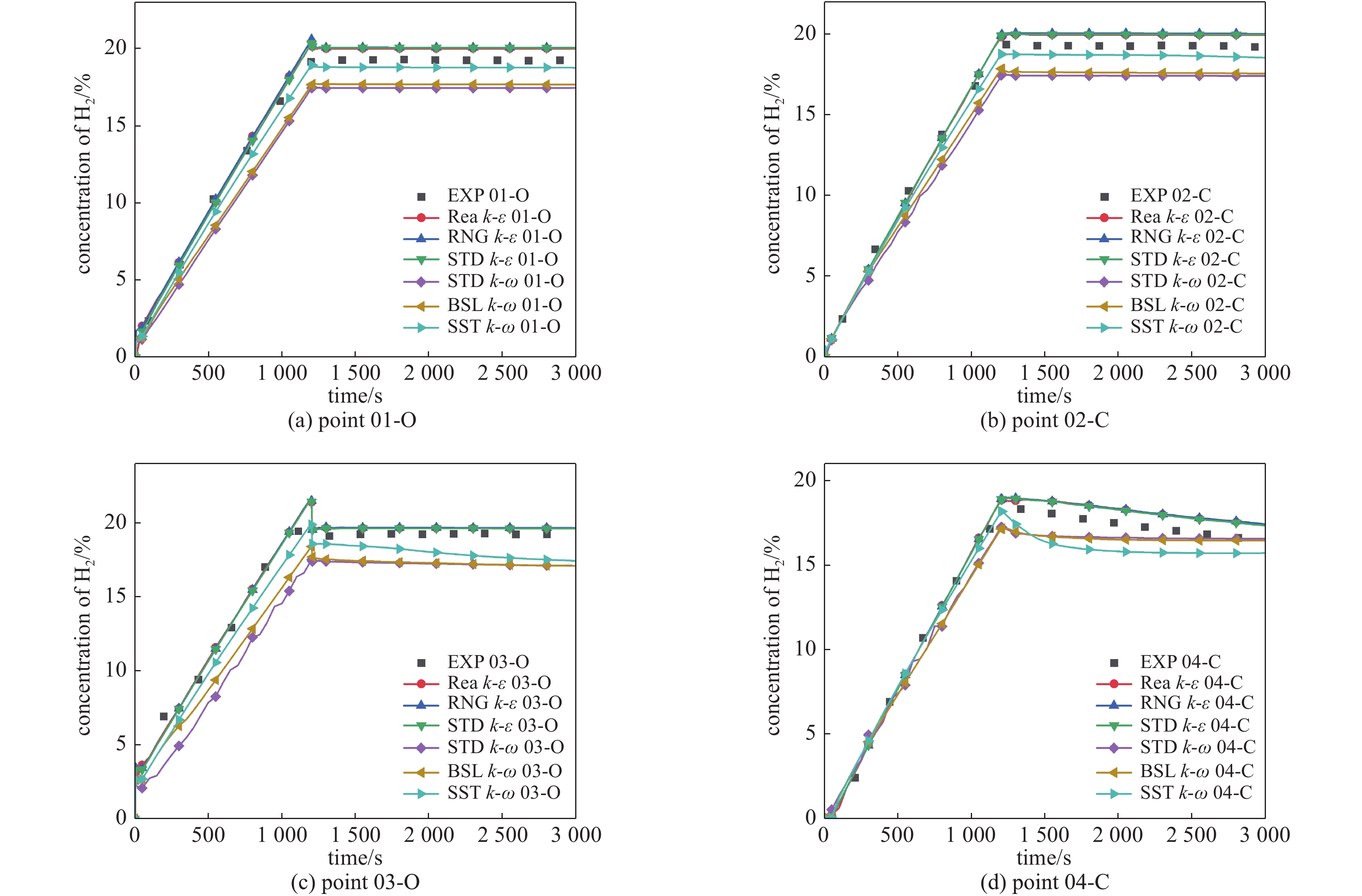Numerical simulation and experimental verification on distribution characteristics of hydrogen flow in single compartment
-
摘要:
以局部隔间氢气流动分布特性研究实验装置中的单个隔间作为几何结构,建立小空间内氢气分布数值研究的计算流体动力学分析模型,对不同湍流模型适用性展开讨论分析,通过对比实验数据和模拟数据,给出最优湍流模型的选择,进一步对低质量流量工况下氢气在小空间内的流动分布进行数值模拟。模拟结果表明:在选取的6种两方程湍流模型中,采用Realizable k-ε、RNG k-ε、Standard k-ε湍流模型计算得到的结果与实验值吻合较好,能够准确地反映氢气在小空间内的释放过程和分布情况;低质量流量工况下,氢气主流区域径向范围较小,氢气在容器中上部呈稳定均匀分布。
Abstract:The distribution characteristics of hydrogen flow in local single space is a special concern of nuclear power plant and hydrogen storage device. In this paper, a single compartment of the experimental device is used as a geometric structure to establish a computational fluid dynamics analysis model for the numerical study of hydrogen distribution in small-scale space. By comparing the experimental data with the simulated data, the choice of the optimal turbulence model is given, and the flow distribution of hydrogen in small-scale space under low mass flow rate condition is simulated. The numerical simulation results obtained by Realizable k-ε, RNG k-ε and Standard k-ε turbulence models in the six two-equation turbulence models agree well with the experimental data, which can accurately reflect the release process and distribution of hydrogen in small-scale space. In low mass flow rate case, the radial range of the mainstream region of hydrogen is small, and hydrogen is stably and evenly distributed in the middle and upper part of the compartment.
-
Key words:
- single compartment /
- hydrogen /
- turbulence model /
- numerical simulation /
- flow distribution
-
轻水堆核电厂在严重事故情况下,反应堆压力容器内锆合金包壳与水或水蒸汽发生锆水反应,产生大量氢气[1]。由于大型干式安全壳具备较大的安全壳容积和较高的极限压力承载能力,氢气不易发生大规模燃烧和整体性爆炸[2]。但在安全壳内局部隔间,如安全壳上部隔间、蒸汽发生器隔间、堆芯补水箱隔间、内置换料水箱隔间、堆芯冷却系统隔间等,氢气浓度易积聚从而发生爆炸的可能性更大。局部小空间内的氢气爆炸有可能破坏安全壳内的设备和建筑结构,形成的飞射物对安全壳的完整性构成威胁。为保证安全壳的完整性、保证核电厂的安全运行、保证人员和环境安全,须有效控制氢气在安全壳空间内的浓度,特别是消除局部小空间内的氢气积聚风险。此外,氢能作为重要的新能源,广泛应用于氢能汽车、石油化工等领域,而氢气的储存及运输作为氢能利用的关键技术,是当前关注的热点之一。
数值模拟是研究氢气流动分布的重要手段,国内外针对核领域和其他领域涉及氢气的迁移分布进行了大量研究。Prasad等人利用替代工质氦气对密闭车库中氢能汽车储氢罐氢气泄漏开展了缩比实验研究[3],并使用火灾动力学模拟器(FDS)模拟了车库中氢气的释放和扩散,其中实验研究主要为FDS评估提供实验数据,模拟结果准确地反映了氢气在缩比封闭空间进行的实验中所测量到的总体趋势,这对氢气消防安全相关的规范和标准制定具有重要意义。法国原子能委员会(CEA)的Cariteau等人[4-5]利用氦气代替氢气进行了受限空间内泄漏速率及通风口面积、数量、位置等因素对氢气泄漏扩散和聚集的影响相关实验研究,结果表明,在完全密闭的情况下,空间上下区域体积分数差异与时间无关,而取决于装置高度、注入的浮力通量和夹带系数。肖建军等人[6]为探讨在模拟大型复杂反应堆安全壳内的氢气分布时湍流模型的重要性,使用GASFLOW程序[7]研究了湍流模型对MISTRA 2009实验中气体分布的影响,研究发现,采用湍流模型时,计算结果在射流源附近局部得到改善;在释放源较远的浮力占主导作用区域,湍流扩散被湍流模型过度预测,使用分子粘度获得的计算结果与实验数据具有一致性。Wilkening等人[8]利用计算流体力学(CFD)程序CFX采用k-ε,SST两种湍流模型对氦气释放和扩散进行了模拟,通过与实验数据对比发现,不同湍流模型在对不同区域氦气浓度预测上存在差异,这进一步表明,对不同的问题进行CFD分析时,总是需要对模型进行讨论。从当前研究现状可以发现,采用CFD方法研究空间内氢气迁移特性时需要特别关注几何特征及湍流模型的适用性。
本文建立小空间内氢气分布数值研究CFD分析模型,对不同湍流模型适用性展开讨论分析,通过对比实验数据和模拟数据,给出最优湍流模型的选择,并以局部隔间氢气流动分布特性研究实验装置中的单个隔间作为实验本体,进行了实验验证。
1. 数值模型
1.1 控制方程
对于所有的流动,三维计算流体动力学程序求解质量和动量的守恒方程。对于涉及传热或可压缩流动,还需求解附加的能量守恒方程。基于有限体积法,将计算域划分为若干控制体,通过对每个控制单元使用离散化方法求解瞬态纳维-斯托克斯方程,得到各参数在空间上的分布。可压缩流体的质量守恒方程、动量守恒方程和能量守恒方程[9]分别为
∂ρ∂t+∇⋅(ρU)=0 (1) ∂(ρU)∂t+∇⋅(ρU⊗U)=−∇p+∇⋅τ+SM (2) ∂(ρhtot)∂t−∂p∂t+∇⋅(ρUhtot)=∇(λ∇T)+∇⋅(U⋅τ)+U⋅SM+SE (3) 式中:
ρ 为密度(kg/m3);U 为速度(m/s);p 为压力(Pa);τ 为应力张量(Pa);SM 为外部动力源;htot 为总焓;λ 为导热系数(W·M−2·K−1);T 为温度(K);SE 为能量源。1.2 几何模型和网格划分
本文选取局部隔间氢气流动分布特性研究实验装置中的单个隔间作为几何模型,容器由上下两端为椭球形封头、中间为直径0.9 m的圆柱形不锈钢筒体组成,总高为5 m,内部自由容积约11 m3。以容器底部内表面为基准标高,在0.9 m标高位置处设置有喷口,喷口直径为30 mm;气体浓度通过质谱仪测量,在距离容器底端内表面0.65,1.5,2.5,3.5,4.35 m标高处设置有浓度测点,装置几何截面及各浓度测点的空间分布如图1所示。
几何模型的网格划分,本文使用了多面体网格划分方式,其网格质量大大优于四面体或六面体网格,且网格数量大幅减少,有利于节省计算资源。为消除网格效应对计算结果的影响,选取了粗网格、中等网格、细网格三种网格划分方案进行网格敏感性分析,其网格单元数量分别14 692,65 230,132 104。三种网格参数如下表1所列。
表 1 三种网格划分参数Table 1. Meshing parameters of three kinds of gridsgrid nodes cells maximum skewness coarse grid 78 997 14 692 0.401 middle grid 264 642 65 230 0.414 fine grid 522 207 132 104 0.413 利用三种不同的网格数量对气体喷放阶段进行计算,得到测点01-O,03-O处氢气浓度变化趋势,如图2所示。通过对比计算结果,三种不同网格量下各测点的氢气浓度随时间变化的趋势基本一致,中等网格和细网格两者计算结果吻合得较好,继续增加网格量对提高计算精度无明显改善,综合考虑计算精度和计算资源,选择中等网格进行后续模拟计算。
1.3 初始条件和边界条件
由于氢气具有易燃、易爆等特性,且Swain等人[10]进行的实验表明,氦气和氢气有很强的相似性,在低浓度下使用是合理的,故实验中采用与其物理化学性质相似的氦气作为替代工质[11],为了与实验数据进行比较,亦使用氦气进行计算,本文中将用“氢气”代替“氦气”进行表述分析。初始时刻,容器内充满常温常压的空气,常温氢气以2.6 m/s的速度通过距容器底部内表面0.9 m处的喷嘴竖直向上注入容器内部空间,氢气喷射时间为1 200 s,氢气注射完毕后关闭阀门,静置1 800 s,实验中氢气质量流量如图3所示。
2. 湍流模型讨论
湍流流动是严重事故工况下安全壳内最基本的热工水力现象,由于湍流本身的随机性和湍流涡尺度的不确定性,在使用CFD程序对氢气的流动分布进行模拟计算时,直接数值模拟是不可行的,必须采取湍流模型的方式进行简化处理,因此,湍流模型的合适与否,直接影响计算结果的准确性。为对比不同湍流模型对计算结果的影响,本节选取目前应用较为广泛的两方程湍流模型,即,Realizable k-ε(Rea k-ε),RNG k-ε,Standard k-ε(STD k-ε),Standard k-ω(STD k-ω),SST k-ω,BSL k-ω六种湍流模型对氢气在小空间内的释放阶段和静置阶段进行模拟计算,通过与实验数据对比,分析不同湍流模型的适用性和氢气在小空间内的大致分布情况。
为定量比较不同湍流模型适用性,将使用不同湍流模型计算得到各测点的氢气浓度与实验数据进行对比,对比结果如图4所示。在监测点01-O,02-C,03-O处,氢气浓度随氢气不断注入而逐渐增加,在1 200 s时达到最大值,静置阶段的氢气浓度实验值基本保持不变,各湍流模型在预测氢气释放阶段和静置阶段的氢气浓度趋势与实验数据一致。在氢气释放阶段,采用k-ε湍流模型计算得到的01-O,02-C,03-O处氢气浓度增长速率与实验数据较为吻合,且发现Rea k-ε,RNG k-ε和STD k-ε三种湍流模型得到的计算结果无差异;采用k-ω湍流模型计算得到的氢气浓度增长速率较实验数据偏小,且SST k-ω计算结果要优于STD k-ω和BSL k-ω的计算结果。在静置阶段,采用k-ε湍流模型计算得到的01-O,02-C,03-O处氢气浓度均高于实验数据,监测点01-O处的最大偏差为3.6%,监测点02-C处的最大偏差为2.5%,监测点03-O处的最大偏差为1.6%;采用k-ω湍流模型计算得到的氢气浓度较实验数据偏小,且SST k-ω湍流模型计算结果要优于STD k-ω和BSL k-ω湍流模型的计算结果,但在监测点03-O处,SST k-ω湍流模型计算得到的氢气浓度存在随时间逐渐偏离实验数据的现象。
在监测点04-C处,氢气浓度表现为在氢气释放阶段逐渐增大、静置阶段有所下降的整体变化趋势。在氢气释放阶段,采用k-ε和SST k-ω湍流模型计算得到的氢气浓度增长速率与实验数据较为吻合;采用STD k-ω和BSL k-ω湍流模型计算得到的氢气浓度增长速率较实验数据偏小。静置阶段,采用k-ε湍流模型计算得到的氢气浓度变化趋势与实验数据变化趋势一致,预测值均高于实验值,最大偏差为5.5%;采用SST k-ω和BSL k-ω湍流模型计算得到的氢气浓度变化呈先减小后稳定的趋势,与实验数据变化趋势差异较大,且SST k-ω湍流模型计算值最大偏差为10%,BSL k-ω湍流模型计算值最大偏差为8.2%。
综上,在考虑模型对各测点氢气浓度变化趋势预测和准确度的前提下,本文采用Standard k-ε湍流模型进行后续的计算分析。
3. 容器内氢气分布
由于实验本体为密闭容器,在0~1 200 s持续注入氢气阶段,各测点氢气浓度不断增加,在1 200 s时氢气浓度达到最大值,其中测点05-C处氢气浓度上升较为缓慢,其原因是该测点位于容器最下部,释放的氢气在到达容器顶部内表面后折返向下运动,在初始动量减少和浮力的双重作用下,扩散到容器底部的氢气量较少;停止氢气注入后,除测点04-C,05-C外,各测点氢气浓度不再增加且保持在19%左右。静置阶段,在测点04-C处出现氢气浓度下降、测点05-C处氢气浓度上升的现象,这是因为两处测点位置位于氢气喷射位置下方,而喷射的氢气在容器中上部积聚,容器下部存在较大氢气浓度梯度,在浓度梯度的驱动下,氢气向容器底部扩散。此外,测点05-C处的氢气浓度增长率随时间增加逐渐减小,直到氢气浓度保持稳定。各列监测点氢气浓度实验数据与模拟数据对比如图5所示。
通过对比实验数据和模拟值可以发现,各测点浓度变化趋势均得到较好预测。在氢气注入阶段,各测点模拟值与实验值吻合较好,最大偏差出现在测点05-C处,这与k-ε模型对扩散效应的高估有关[12];静置阶段,各测点模拟结果较实验结果偏大。其次,对比各列测点氢气浓度变化可以看出,O列测点在氢气注入初始时刻和氢气注入结束时刻存在骤升和骤降的情况,且随测点高度增加氢气浓度递减,原因是O列测点在氢气释放位置正上方,氢气注入后,在初始动量的主导下,首先流经位于氢气主流区域内的O列各测点,氢气浓度快速增加,在氢气喷口下游区域,主流氢气对周围空气的卷吸作用使得氢气浓度沿轴向距离递减[13]。由于主流区域氢气径向浓度分布服从高斯分布[14],氢气注入结束后,氢气和周围空气混合使得O列各测点氢气浓度降低。此外,由A列和O列测点氢气注入结束时刻浓度值可得,该工况下氢气主流区域径向范围小于200 mm。
4. 结 论
本文使用三维CFD方法,针对局部隔间氢气流动分布特性研究实验装置中的单个隔间建立分析模型,首先对程序中内置的不同两方程湍流模型适用性展开讨论分析,给出湍流模型的选择,然后对氢气在小空间内的释放阶段和静置阶段进行模拟。通过实验及数值模拟的对比和分析,得到如下结论:(1)在选取的6种两方程湍流模型中,采用Realizable k-ε,RNG k-ε,Standard k-ε湍流模型计算得到的结果和实验值较吻合,可以用于氢气流动分布行为研究;(2)低质量流量工况下,氢气主流区域径向范围较小,氢气在容器中上部呈稳定均匀分布。
-
表 1 三种网格划分参数
Table 1. Meshing parameters of three kinds of grids
grid nodes cells maximum skewness coarse grid 78 997 14 692 0.401 middle grid 264 642 65 230 0.414 fine grid 522 207 132 104 0.413 -
[1] Dimmelmeier H, Jürgen E, Movahed M A. Computational validation of the EPR combustible gas control system[J]. Nuclear Engineering and Design, 2012, 249: 118-124. doi: 10.1016/j.nucengdes.2011.08.053 [2] Deng Jian, Cao Xuewu. A study on implementing a passive autocatalytic recombiner PAR-system in the large-dry containment[J]. Nuclear Engineering and Design, 2008, 238(7): 2554-2560. [3] Prasad K, Pitts W M, Yang J C. A numerical study of the release and dispersion of a buoyant gas in partially confined spaces[J]. International Journal of Hydrogen Energy, 2011, 36(8): 5200-5210. doi: 10.1016/j.ijhydene.2011.01.118 [4] Cariteau B, Brinster J, Tkatschenko I. Experiments on the distribution of concentration due to buoyant gas low flow rate release in an enclosure[J]. International Journal of Hydrogen Energy, 2011, 36(3): 2505-2512. doi: 10.1016/j.ijhydene.2010.04.054 [5] Cariteau B, Tkatschenko I. Experimental study of the effects of vent geometry on the dispersion of a buoyant gas in a small enclosure[J]. International Journal of Hydrogen Energy, 2013, 38(19): 8030-8038. doi: 10.1016/j.ijhydene.2013.03.100 [6] Xiao Jianjun, Travis J R. How critical is turbulence modeling in gas distribution simulations of large-scale complex nuclear reactor containment?[J]. Annals of Nuclear Energy, 2013, 56: 227-242. doi: 10.1016/j.anucene.2013.01.016 [7] Müller C, Hughes E D, Niederauer G F, et al. GASFLOW: A computational fluid dynamics code for gases, aerosols, and combustion, volume 3: Assessment manual[J]. Office of Scientific & Technical Information Technical Reports, 1998. [8] Wilkening H, Baraldi D, Heitsch M. CFD simulations of light gas release and mixing in the Battelle Model-Containment with CFX[J]. Nuclear Engineering and Design, 2008, 238(3): 618-626. doi: 10.1016/j.nucengdes.2007.02.042 [9] Peng Cheng, Tong Lili, Cao Xuewu. Numerical analysis on hydrogen stratification and post-inerting of hydrogen risk[J]. Annals of Nuclear Energy, 2016, 94: 451-460. doi: 10.1016/j.anucene.2016.04.029 [10] Swain M R, Shriber J, Swain M N. Comparison of hydrogen, natural gas, liquified petroleum gas, and gasoline leakage in a residential garage[J]. Energy & fuels, 1998, 12(1): 83-89. [11] Agranat V, Cheng Z, Tchouvelev A. CFD modeling of hydrogen releases and dispersion in hydrogen energy station[C]//Proceedings of the 15th World Hydrogen Energy Conference. 2004. [12] Sonnenkalb M, Poss G. The international test programme in the THAI facility and its use for code validation[C]//EUROSAFWE Forum. 2009. [13] Schefer R W, Houf W G, Williams T C. Investigation of small-scale unintended releases of hydrogen: Buoyancy effects[J]. International Journal of Hydrogen Energy, 2008, 33(17): 4702-4712. doi: 10.1016/j.ijhydene.2008.05.091 [14] Houf W, Schefer R. Analytical and experimental investigation of small-scale unintended releases of hydrogen[J]. International Journal of Hydrogen Energy, 2008, 33(4): 1435-1444. doi: 10.1016/j.ijhydene.2007.11.031 期刊类型引用(3)
1. 郭容达,张丹迪,曹学武. 抑压水池温度分层影响因素. 强激光与粒子束. 2022(08): 157-161 .  本站查看
本站查看2. 张静,黄玉玺,张巍,郭万年,李龙龙. 车库燃料汽车氢气泄漏模拟与分析. 太原理工大学学报. 2022(06): 1068-1075 .  百度学术
百度学术3. 姚志安,康壮苏,倪雅,左新龙. 不同钢丝堆积态下悬索桥主缆除湿性能. 科学技术与工程. 2021(09): 3807-3813 .  百度学术
百度学术其他类型引用(2)
-


















 下载:
下载:





 下载:
下载:










